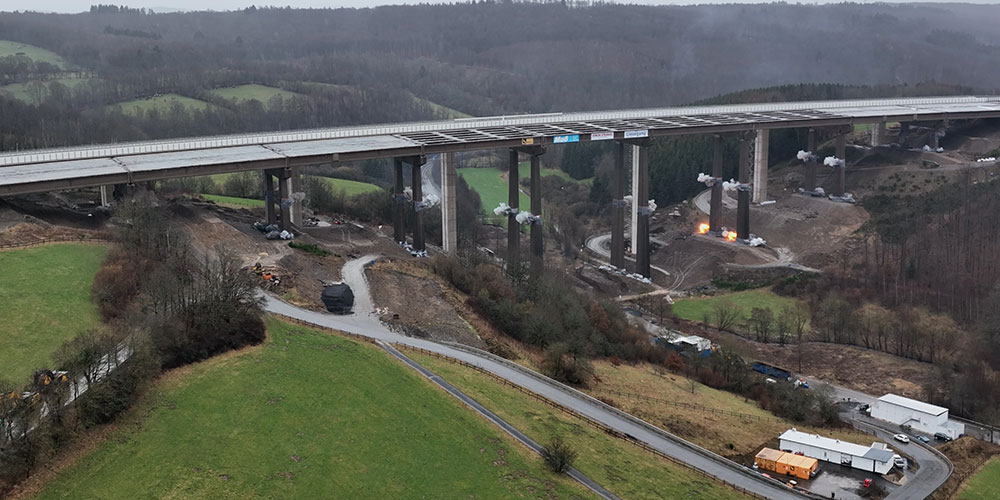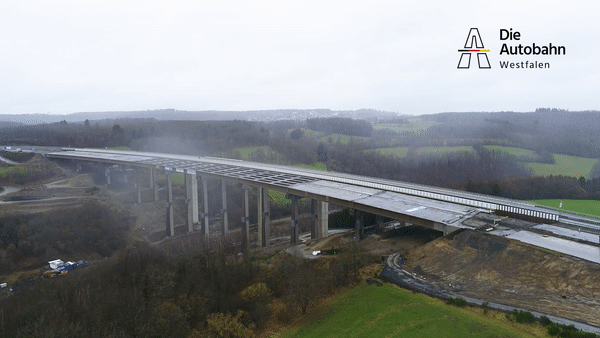It’s not every day a bridge is demolished with such precision and simplicity.
Earlier this year, locals gathered to witness the controlled demolition of the 72-metre-high Rinsdorf viaduct in North Rhine-Westphalia, Germany.
The superstructure’s eight pairs of pillars were exploded with surprising simplicity, leading to the bridge collapsing and falling to the ground below within seconds.
Demolition experts used 120 kilograms of explosives to demolish the bridge, which spans a gap of 485 m on the A45 autobahn, part of Germany’s extensive highway system.
The project, led by demolisher Michael Schneider, set a record for the tallest bridge demolition in the country.
“Three hours before the blast, 59 barricades moved into position to seal off the restricted area around the viaduct,” Director of the Westphalia autobahn Elfriede Sauerwein-Braksiek said. “An hour beforehand, the A45 was completely closed in both directions.”
Four seconds after 11 o’clock, the demolishers ignited the explosives and the bridge began to fall.
“After four hours, structural inspectors gave the go-ahead that no damage had been found on the new bridge,” Sauerwein-Braksiek said.
The new bridge, which runs parallel to the old structure, was not harmed by the demolition due to the precise planning by experts.
The 55-year-old viaduct was in dire need of replacement.
Crowds of onlookers gathered to watch the spectacle, which has been reported on across the globe.


An Australian perspective
Engineers Australia Engineering Technologist Fellow and Director of engineering consulting company De-Consult, Will Neethling TFIEAust CEngT said the event was an example of demolition engineering done right.
“In countries like Germany and Australia, we apply proper engineering principles to analyse and assess the situation, so that when the demolition does occur, it normally occurs as intended,” he said.
“It’s clear that [the engineers in Rinsdorf] considered exactly how the structure was going to behave.
“They’ve collapsed the columns by creating a weak point or an eccentricity halfway up the columns, which means that they collapse under the weight of the bridge and the horizontal force of the explosive charge.
“It seems to me to be a well-engineered, properly planned exercise.”
Neethling said the demolition differs from previous superstructure demolitions that did not go to plan, such as the Royal Canberra Hospital implosion in 1996, which killed one onlooker and injured nine others.
“In the wake of the Canberra disaster, it’s unlikely a high-rise building will be demolished in Australia in a metropolitan area in the foreseeable future,” he said.
“But the reality is that explosive demolition, done properly, is the most efficient way of demolishing large or tall structures.”
The scale and spectacle of explosions like the Rinsdorf viaduct are sure to attract interest from non-engineers, but there’s a certain skill involved in successfully executing demolitions of any kind, he said.
“Smaller structures, particularly industrial steel frame structures, can actually be demolished by mechanical excavators or other techniques,” Neethling said. “From a purist engineering point of view [this] is more impressive, but general engineers and the general public will probably see the explosive demolition as more impressive.
“There is a lot of engineering and science that goes into planning a major demolition properly.”
The motorway operator in Germany, Die Autobahn, said its Westphalia branch is responsible for 1385 km of road, 2330 bridges and 11 tunnels.
German Parliamentary State Secretary in the Federal Ministry of Transport and Digital Infrastructure Oliver Luksic said the German government would invest 4.5 billion euros in the North Rhine-Westphalia region this year.
Further demolitions are scheduled for October 2022 and February 2023.
